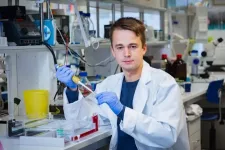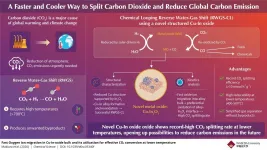Limits of atomic nuclei predicted
Scientists simulate large region of the chart of nuclides
2021-01-13
(Press-News.org) Atomic nuclei are held together by the strong interaction between neutrons and protons. About ten percent of all known nuclei are stable. Starting from these stable isotopes, nuclei become increasingly unstable as neutrons are added or removed, until neutrons can no longer bind to the nucleus and "drip" out. This limit of existence, the so-called neutron "dripline", has so far been discovered experimentally only for light elements up to neon. Understanding the neutron dripline and the structure of neutron-rich nuclei also plays a key role in the research program for the future accelerator facility FAIR at the GSI Helmholtz Centre for Heavy Ion Research in Darmstadt.
In a new study, "Ab Initio Limits of Nuclei," published in the journal Physical Review Letters as an Editors' Suggestion with an accompanying synopsis in APS Physics, Professor Achim Schwenk of TU Darmstadt and a Max Planck Fellow at the MPI for Nuclear Physics in Heidelberg, together with scientists from the University of Washington, TRIUMF and the University of Mainz, succeeded in calculating the limits of atomic nuclei using innovative theoretical methods up to medium-mass nuclei. The results are a treasure trove of information about possible new isotopes and provide a roadmap for nuclear physicists to verify them.
The new study is not the first attempt to theoretically explore the extremely neutron-rich region of the nuclear landscape. Previous studies used density functional theory to predict bound isotopes between helium and the heavy elements. Professor Schwenk and colleagues, on the other hand, explored the chart of nuclides for the first time based on ab initio nuclear theory. Starting from microscopic two- and three-body interactions, they solved the many-particle Schrödinger equation to simulate the properties of atomic nuclei from helium to iron. They accomplished this by using a new ab initio many-body method - the In-Medium Similarity Renormalization Group -, combined with an extension that can handle partially filled orbitals to reliably determine all nuclei.
Starting from two- and three-nucleon interactions based on the strong interaction, quantum chromodynamics, the researchers calculated the ground-state energies of nearly 700 isotopes. The results are consistent with previous measurements and serve as the basis for determining the location of the neutron and proton driplines. Comparisons with experimental mass measurements and a statistical analysis enabled the determination of theoretical uncertainties for their predictions, such as for the separation energies of nuclei and thus also for the probability that an isotope is bound or does not exist (see figure).
The new study is considered a milestone in understanding how the chart of nuclides and the structure of nuclei emerges from the strong interaction. This is a key question of the DFG-funded Collaborative Research Center 1245 "Nuclei: From Fundamental Interactions to Structure and Stars" at the TU Darmstadt, within which this research was conducted. Next, the scientists want to extend their calculations to heavier elements in order to advance the input for the simulation of the synthesis of heavy elements. This proceeds in neutron-rich environments in the direction of the neutron dripline and occurs in nature when neutron stars merge or in extreme supernovae.
INFORMATION:
ELSE PRESS RELEASES FROM THIS DATE:
2021-01-13
The levels of small molecules called microRNAs (miRNAs) circulating in blood could help identify early on children with life-threatening forms of malaria, according to a study led by the Barcelona Institute for Global Health, an institution supported by "la Caixa" Foundation, in collaboration with the Manhiça Health Research Center (CISM) in Mozambique. The results, published in Emerging Infectious Diseases journal, could also help better understand the mechanisms underlying severe malaria.
Malaria mortality among young African children remains unacceptably high. To improve the outcome, it is important to rapidly identify and treat children with severe forms of the disease. ...
2021-01-13
Overview:
Associate professor Masaya Tamura, Kousuke Murai (who has completed the first term of his master's program), and their research team from the Department of Electrical and Electronic Information Engineering at Toyohashi University of Technology have successfully transferred power and data wirelessly through seawater by using a power transmitter/receiver with four layers of ultra-thin, flat electrodes. In the field of wireless power transfers, seawater behaves as a dielectric with extremely high loss, and achievement through capacitive coupling is difficult. Up until now, it had been thought that wireless power transfers could only be achieved through magnetic coupling. ...
2021-01-13
Researchers from the University of Seville and the University of Pavia have identified a link between Amyotrophic Lateral Sclerosis (ALS) and the accumulation of DNA-RNA hybrids in the genome. The accumulation of these hybrids causes increased genomic damage and boosts genetic instability. This finding will make it possible to better understand the molecular basis of the disease, as well as to propose new solutions to curb it.
Amyotrophic Lateral Sclerosis (ALS) is a neurodegenerative disease of the central nervous system, characterised by progressive degeneration ...
2021-01-13
The descendants of regular wild-type bacteria can evolve to survive for a long time on metallic copper surfaces that would usually kill them within a few minutes. An international research team led by Martin Luther University Halle-Wittenberg (MLU) and the Bundeswehr Institute of Microbiology was able to produce these tiny survivalists in the lab and has been able to study them more closely. The team reports on its findings in Applied and Environmental Microbiology.
Bacterial infections are usually treated with antibiotics. However, in recent decades many pathogenic bacteria have developed an increasing tolerance to common drugs. So-called multidrug-resistant bacteria are of particular concern as ...
2021-01-13
It is politically agreed and necessary for climate protection reasons that our entire economy becomes climate-neutral in the coming decades - and that applies to air travel, too. This is a technically feasible goal, and there are numerous ways to achieve it. ETH Professor Marco Mazzotti and his team have now compared the options that appear to be the easiest to implement in the short and medium term and evaluated them according to factors such as cost-effectiveness.
The ETH researchers conclude that the most favourable option is to continue powering aircraft with fossil fuels in future, but then remove the associated CO2 emissions from the atmosphere ...
2021-01-13
Fuchs' corneal dystrophy is one of the most common eye diseases diagnosed in almost 5% of the population of Europe aged 40 years or over. It is a hereditary eye disease that causes vision impairment and typically manifests in middle age. The first symptoms of the disease - blisters on the surface of your cornea - resemble cataract at first glance. The disease progresses from the centre of the cornea affecting all layers of the cornea. The progression of the disease varies from individual to individual and in severe cases results in vision loss.
The molecular neurobiology ...
2021-01-13
With ever-worsening climate change, there is a growing need for technologies that can capture and use up the atmospheric CO2 (carbon dioxide) and reduce our carbon footprint. Within the realm of renewable energy, CO2-based e-fuels have emerged as a promising technology that attempts to convert atmospheric CO2 into clean fuels. The process involves production of synthetic gas or syngas (a mixture of hydrogen and carbon monoxide (CO)). With the help of the reverse water-gas shift (RWGS) reaction, CO2 is broken down into the CO necessary for syngas. While promising in its conversion efficiency, the RWGS reaction requires incredibly high temperatures (>700°C) to proceed, while also generating ...
2021-01-13
In a new study, researchers at Karolinska Institutet in Sweden have used a urine test to identify and verify a patient's type of asthma. The study, which has been published in the American Journal of Respiratory and Critical Care Medicine, lays the foundation for a more personalized diagnosis and may result in improved treatment of severe asthma in the future.
About 10 percent of the Swedish population suffers from asthma, a disease that has become increasingly widespread over the past 50 years, with annual global mortality of around 400,000 according to the World Health Organization. Asthma is characterized by chronic inflammation in the airways, which can result in symptoms including ...
2021-01-13
In three recent publications in Molecular Psychiatry, Brain and JAMA Neurology researchers from the University of Gothenburg provide convincing evidence that an in-house developed blood test for Alzheimer's disease can detect the disease early and track its course, which has major implications for a potential use in clinical practice and treatment trials.
"This is an extremely dynamic research field right now, thanks to the technological development and seminal scientific progress in the past years. The dream scenario is to have a blood test for the early detection and screening of Alzheimer's disease up and running. That would give significantly ...
2021-01-13
Workaholism or work addiction risk is a growing public health concern that can lead to many negative mental and physical health outcomes such as depression, anxiety or sleep disorder. Perception of work (job demands and job control) may become a major cause of employees' work addiction. The international group of researchers including the HSE University scientist explored the link between work addiction risk and health-related outcomes using the framework of Job Demand Control Model. The results were published in the International Journal of Environmental Research and Public Health.
Workaholics are people who usually work seven and more hours more than ...
LAST 30 PRESS RELEASES:
[Press-News.org] Limits of atomic nuclei predicted
Scientists simulate large region of the chart of nuclides





